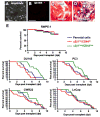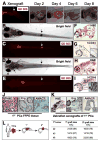Enrichment of human prostate cancer cells with tumor initiating properties in mouse and zebrafish xenografts by differential adhesion
- PMID: 24154958
- PMCID: PMC3939797
- DOI: 10.1002/pros.22740
Enrichment of human prostate cancer cells with tumor initiating properties in mouse and zebrafish xenografts by differential adhesion
Abstract
Background: Prostate tumor-initiating cells (TICs) have intrinsic resistance to current therapies. TICs are commonly isolated by cell sorting or dye exclusion, however, isolating TICs from limited primary prostate cancer (PCa) tissues is inherently inefficient. We adapted the collagen adherence feature to develop a combined immunophenotypic and time-of-adherence assay to identify human prostate TICs.
Methods: PCa cells from multiple cell lines and primary tissues were allowed to adhere to several matrix molecules, and fractions of adherent cells were examined for their TIC properties.
Results: Collagen I rapidly-adherent PCa cells have significantly higher clonogenic, migration, and invasion abilities, and initiated more tumor xenografts in mice when compared to slowly-adherent and no-adherent cells. To determine the relative frequency of TICs among PCa cell lines and primary PCa cells, we utilized zebrafish xenografts to define the tumor initiation potential of serial dilutions of rapidly-adherent α2β1(hi) /CD44(hi) cells compared to non-adherent cells with α2β1(low) /CD44(low) phenotype. Tumor initiation from rapidly-adherent α2β1(hi) /CD44(hi) TICs harboring the TMPRSS2:ERG fusion generated xenografts comprising of PCa cells expressing Erg, AMACR, and PSA. Moreover, PCa-cell dissemination was consistently observed in the immune-permissive zebrafish microenvironment from as-few-as 3 rapidly-adherent α2β1(hi) /CD44(hi) cells. In zebrafish xenografts, self-renewing prostate TICs comprise 0.02-0.9% of PC3 cells, 0.3-1.3% of DU145 cells, and 0.22-14.3% of primary prostate adenocarcinomas.
Conclusion: Zebrafish PCa xenografts were used to determine that the frequency of prostate TICs varies among PCa cell lines and primary PCa tissues. These data support a paradigm of utilizing zebrafish xenografts to evaluate novel therapies targeting TICs in prostate cancer.
Keywords: prostate cancer stem cells; tumor-initiating cells; zebrafish.
© 2013 Wiley Periodicals, Inc.
Conflict of interest statement
All authors declare no competing interest.
Figures





References
-
- Isaacs JT. In: Control of cell proliferation and cell deathin the normal and neoplastic prostate: A stem cell model. Rodgers CHCD, Cunha G, Grayhack JT, Hinman F Jr, Horton R, editors. Washington DC: US Department of Health and Human Services; 1987.
-
- Isaacs JT, Kyprianou N. Biological basis for chemohormonal therapy for prostatic cancer. Cancer Treat Res. 1989;46:177–193. - PubMed
-
- Collins AT, Berry PA, Hyde C, Stower MJ, Maitland NJ. Prospective identification of tumorigenic prostate cancer stem cells. Cancer Res. 2005;65(23):10946–10951. - PubMed
-
- Dick JE. Stem cell concepts renew cancer research. Blood. 2008;112(13):4793–4807. - PubMed
Publication types
MeSH terms
Substances
Grants and funding
LinkOut - more resources
Full Text Sources
Other Literature Sources
Medical
Research Materials
Miscellaneous

